Costas Christ is the senior director for ecotourism at Conservation International, a U.S.-based NGO working in 30 countries with a mission to conserve global biodiversity and to demonstrate that human societies are able to live harmoniously with nature. He is also the chair of the board of directors of the International Ecotourism Society.

Monday, 18 Mar 2002
NAIROBI, Kenya
On Jan. 28, the United Nations officially declared 2002 the International Year of Ecotourism. Despite such high profile attention, ecotourism remains widely misunderstood. Too often people confuse nature tourism — wildlife safaris, bird watching, jungle treks, etc. — with ecotourism. They are not the same thing. Ecotourism is directly linked to conserving nature and bringing benefits to local people. The most widely accepted definition of ecotourism today is articulated by the International Ecotourism Society, founded in 1990: “Ecotourism is responsible travel to natural areas that protects nature and sustains the well-being of local peoples.” A jungle tour may offer a great travel experience but it is not ecotourism unless it is directly linked to the principles for which ecotourism is known, namely protecting nature and bringing tangible economic benefits to local people. You either have it (or at least some part of it) or you don’t. The definition and the principles are clear. Putting them into practice is where the greatest challenge lies.
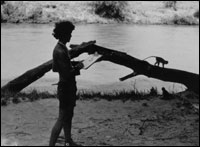
At work studying Vervet Monkeys in Samburu, Kenya in 1978.
My own journey into the world of ecotourism was more by chance than planning. Twenty-four years ago, young and eager to pursue my dream of becoming a wildlife ecologist, I landed a position as assistant researcher on a Harvard University field study of wild Vervet monkeys in Kenya. I arrived in 1978 with all the enthusiasm of anyone travelling to Africa for the first time. Living out of a tent in Samburu Game Reserve, I spent day after day conducting focal point behavior samples of Vervets in one of Kenya’s most remote and spectacular settings. I was immersed in a world of incredible nature where the only people I saw were either the tourists who stayed in the fancy game lodges while on safari or the local Samburu tribesmen who eked out a living on the edge of the reserve.
One day a massive brush fire appeared out of nowhere and swept through the reserve, heading straight for the main tourist lodge in the park and burning everything in its path. Animals fled to escape the flames and I joined the lodge workers and a handful of poorly-equipped rangers in an effort to stop the blaze from advancing. In the end, the safari lodge narrowly escaped damage. Covered in soot and scorched by the heat, the park warden and I shared a canteen of water. What he said next took me by surprise: “They hate the park.” “Who?” I asked, still feeling the pain of smoke in my lungs. “The villagers,” he replied and then was called over to some waiting rangers.
In my naivete, I wondered how could anyone hate a national park? How could anyone hate something that was set up to save nature? Why burn down a tourist lodge? I decided to seek the answers among the Samburu peoples themselves. What I found out startled me. As I got to know the local villagers better, they talked openly to me about their contempt for the game reserve that forced them off of their traditional land to create a protected area for wildlife. They expressed anger at tourists who spent millions of dollars to visit Samburu Game Reserve while on safari and stay at the fancy lodges while the local people had no wells, no schools, no clinics, and struggled for basic needs. Why, they asked bitterly, should they support a park that left them worse off than before?
These conversations with local villagers and park staff during my time in Samburu led to a personal turning point for me. It became clear that unless the local people who live closet to the natural areas we seek to protect become partners and allies in the struggle to save nature, then conservation would not succeed in the long run. Policing parks and enforcement efforts will never be enough to save a protected area in a place like Africa if the park’s closest neighbors are conservation enemies. Local populations need to be partners in conserving nature.
To make that happen, I believed then — and still do today — than these same local people need to be the direct beneficiaries of conservation efforts. Only when local people see preserving nature as a fundamental benefit towards their own livelihood, will the Earth’s last pristine places and its rare and endangered wildlife have a fighting chance to survive. Nature tourism, which was accounting for hundreds of millions of dollars in revenue, could be the link in the chain, I thought, that could deliver economic benefits — not just to some wealthy businessman based in a capital city somewhere, but to the local people who lived on and near the land where tourists visit.
My experience in Kenya in the late 1970s inspired me to leave wildlife field research behind and embark on a new direction. At the time, I called it, “Conservation Sociology.” By 1989, another name had emerged — “Ecotourism” — and with it a movement to promote responsible tourism as a way to protect nature and sustain the well being of local peoples gained steam. This week, I welcome you to join me as I return to Africa and take a first hand look at efforts underway that are making ecotourism a reality.
Tuesday, 19 Mar 2002
SHAMPOLE, Kenya
Six years ago, David Western, then director of the Kenya Wildlife Service, told me about a place called Shampole in the Rift Valley, near the Kenya-Tanzania border. “The area has tremendous potential for an ecotourism project,” he said. “The local people want to find a way to benefit from wildlife on their land and an opportunity exists to create community-based conservation in an area where poaching has been a major threat.”
The local people he was talking about are the Maasai, nomadic cattle herders who are thought to have migrated to Kenya from the Sudan. The Maasai, including those at Shampole, maintain goats as well as cows, but they believe that they have been selected by their god, “Enkai,” to be the keepers of cattle.
Many people around the world have seen Shampole, although they probably do not realize it. Because of its remote location and rugged beauty, the region was used in a scene in the movie Out of Africa to portray unspoiled Africa. Shampole was then and still is today a remote area of rugged beauty. Not surprisingly, after the film’s release, intrepid travelers began to show up in the area, lured by its isolation and by curiosity about the lives of the Maasai. But Shampole had suffered from years of poaching, and the area was at risk of becoming a wild place without much wildlife.
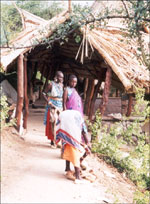
Women at work in the ecolodge they helped build.
The Shampole Maasai, noticing the interest of adventure-oriented travelers, wanted to find a way to make money from the area’s significant natural resources. They approached David Western and his newly formed Kenyan NGO, Africa Conservation Centre, for assistance. Western saw an opportunity to save wildlife in the area while helping the local Maasai bring needed income into a largely impoverished region of Kenya. The key was ecotourism.
As far back as the 1970s, Western had been looking at human-wildlife conflicts in East Africa, and he believed that carefully planned and implemented tourism could be a way to turn such conflicts into opportunities for conservation and community development. When my experiences working in the Samburu Game Reserve in the late 1970s led me to the same conclusions, I went looking for Western. We met for the first time in Nairobi in 1978. Neither of us used the word “ecotourism” in that initial meeting, but we were talking about it all the same — about how to promote a new and more responsible kind of tourism to benefit local communities and achieve lasting conservation.
Today, I am seated next to Western in his blue and white Cessna bound for Shampole. We are joined by Neel Inamdar, the executive director of the Africa Conservation Centre, who has been working with the Shampole Maasai to support ecotourism development. We lift off into a morning sky of low clouds and mist coming off of the Ngong Hills.

Costas Christ with David Western and Neel Inamdar of the Africa Conservation Centre, standing beside the Cessna at Shampole.
As we head southwest, I watch the land go from small farm plots called shambas to wide open expanses of savannah dotted with acacia trees. Recent rains have turned the usually brown landscape green. Dirt roads meander until they disappear into foot paths. Here and there we can see Maasai manyattas, small circular traditional villages surrounded by a thorn bush fence to keep wild animals out and the Maasai and their livestock safely within.
As we approach Shampole, I begin to spot wildlife below us: six zebras around a water hole, a group of wildebeest with calves in the shade of an acacia tree, giraffe and gazelles in an open clearing. We fly over the southern Uaso Nyiro river which forms the boundary of the newly created Shampole Community Conservation Area and a tiny dirt air strip comes into view. Our plane descends as a Land Rover bounces down a dirt track to meet us, leaving a trail of red dust in its wake.
With the help of the African Conservation Centre (ACC), Shampole is emerging as a model ecotourism project, driven by the community’s own initiative. The Maasai of Shampole Group Ranch — a traditional communal system of land ownership — stated their goals quite clearly when they approached ACC and Western for help. They wanted to benefit economically from wildlife while preserving and protecting their own way of life. That did not mean that they did not want outside education for their children or a local health clinic or a permanent well. Rather, the Maasai had their owns ideas of what they wanted and what type of change they would welcome. Most importantly, they wanted to make those decisions themselves.
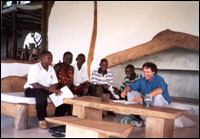
Talking ecotourism with members of the Shampole Maasai community.
The Maasai, who contributed the building materials, the land, and their in-depth knowledge of the local environment, were one of three key players in the success of the Shampole Community Ecotourism Development Project, as it is known. Anthony Russell and his company, Art of Journeys, invested the funds to build the lodge, employing over 100 local community members, and provided the marketing and management knowledge needed to run it. Finally, ACC helped facilitate dialogue between the investor and the community and supported local training to build the Maasai knowledge of ecotourism and enhance their conservation-management skills. The result is that the Shampole Maasai own 30 percent of the ecolodge with an agreement to become 80 percent shareholders within 10 years. The community continues to maintain all legal rights to the land. They have named the ecolodge “Maaoleng” which means, appropriately, “completely Maasai.”
Shampole ecolodge is perhaps the finest safari facility in all of Kenya — a true five-star wilderness experience. The setting and the lodge are nothing short of spectacular, and the community and its partners are extremely proud of their accomplishment. A 25,000 acre conservation area has been set aside and wildlife is steadily returning to the area, including recent signs of African wild dogs — a critically endangered species. Lion and cheetah have both returned, as have elephants.
The income from the ecolodge goes directly into a trust fund managed by a community board of trustees, with 50 percent designated for community conservation activities, including training of local rangers and anti-poaching patrols, and 50 percent for social development projects, including water, health, and education. In just over two months of operation, the ecolodge has generated $15,000. The European Union’s Biodiversity Conservation Program has also stepped in with funding to create a community-managed conservation trust to further support Shampole’s conservation activities.
Joseph Munge, a Maasai born and raised in Shampole and one of the leaders of the project, smiles as he says to me, “My people now see wildlife as a benefit and not as a threat. The wild animals are returning to our land and we are better off as a result. This is as it should be.” I agree. It is a great example of ecotourism in action — where conservation and local people benefit together.
Wednesday, 20 Mar 2002
IL N’GWESI, Kenya
Ecotourism is proving to be one of the few ways that indigenous groups in Kenya, such as the Maasai, are managing to hold onto their traditional communal land ownership system, known as a group ranch, which is the cornerstone of their way of life. The Maasai have been under increasing pressure from the Kenyan government to subdivide their land into individual plots, which would not only end their pastoral existence, but would also be a conservation disaster. (Maasai land is home to the majority of wildlife in Kenya.)

Il’Ngwesi wilderness conservation area.
Ecotourism is one way the Maasai are responding to this pressure. Simply put, the government is eager to promote economic development and fully aware that wildlife-based tourism is one of the mainstays of the economy. That kind of tourism cannot exist without open land. Neither can the Maasai way of life.
Shampole, which I discussed yesterday, is one of Kenya’s latest examples of successful community-based ecotourism among the indigenous Maasai, but it is neither the first nor the best-known. That title goes to Il’Ngwesi Group Ranch in northern Kenya, one of the most successful examples of community-based ecotourism in Africa. I first heard of Il’Ngwesi in 1995, when the project was just getting underway. Faced with growing insecurity in the area from cattle rustling, the decimation of wildlife from outside poaching, a lack of economic opportunity, and unmet basic needs such as education and medicine, the Maasai of Il’Ngwesi turned to ecotourism to protect their land and generate local benefits.
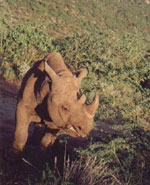
A rare black rhino at Il’Ngwesi.
And it’s working. Since the Il’Ngwesi ecolodge (which is 100-percent owned and managed by the Maasai) opened in 1996, it has received a number of ecotourism-related awards and about 1,000 visitors per year. In 2000, these visitors generated some $85,000 in ecotourism income for the local community.
Kipkori Nteere, the Maasai manager of Il’Ngwesi, was born and raised here and has been involved with the project from the beginning. “When several of us, including some of our elders, first began discussing the idea of ecotourism with the 8,000 members of our group ranch, many people were worried that the outside organizations who were willing to help us get started would take our land away,” he said. “It took time to build trust among our people, but once that trust was established, the entire community supported the project. They began to see the results and they liked what they saw. Security has returned to our land, income is coming in from the ecolodge to help pay for schools fees, and poaching is gone.”
Il’Ngwesi ecolodge is a conservation success story as much as it is an income-generating project. In recent research, John Wathaika, one of Kenya’s leading ecologists, reports that wildlife inside the Il’Ngwesi conservation area has increased 500 percent in the last six years. Of the 19 large mammals native to the area, 17 are now found within Il’Ngwesi, including increased numbers of Grevys zebra, one of the worlds most endangered species. By comparison, only 4 of the 19 native mammal species are found outside of the conservation area. “The Il’Ngwesi ecotourism project has resulted in a dramatic increase in biodiversity within the community conservation area,” John told me at a meeting we both attended with Il’Ngwesi Maasai elders and the community project management committee.

Costas Christ with John Wathaika.
Perhaps the greatest measure of Il’Ngwesi’s success can be found among the local Maasai themselves. When I arrived at Il’Ngwesi, another Maasai community called Kalama was meeting with Il’Ngwesi community members to ask for advice and support to start a similar project on the nearby Kalama Group Ranch. Il’Ngwesi has already helped two other Maasai communities in the area to establish ecotourism projects; all three communities work together in an informal ecotourism network called the North Kenya Community Ecolodges. This is a great example of direct Maasai-to-Maasai assistance and knowledge-sharing, and of how indigenous people in East Africa are directly benefiting from ecotourism.
There’s no question that Il’Ngwesi’s ecotourism accomplishments are the result of cooperation and hard work. Donor support was sought and secured early on and local Kenyan NGOs, including the Africa Conservation Centre and Lewa Downs Nature Conservancy, assisted with community training and capacity building. That is the meaning of partnership. But at the end of the day, this is a Maasai community ecotourism project, and the real success rests with the integrity and initiative of the Maasai of Il’Ngwesi.
Back from a walk through the African bush where a young Maasai warrior was teaching me how to track lions though the rocks and sand, I pause and look out at the wilderness extending for miles around me and feel privileged to be here. Successful ecotourism is challenging work, but examples such as Il’Ngwesi are helping to chart the way.
Thursday, 21 Mar 2002
SAMBURU, Kenya
I am driving into the Northern Frontier District, a hot dry wind blowing through the open windows of my Land Rover as white dust kicks up behind me. I pass acacia bushes and jagged rock outcrops in a landscape that looks prehistoric. This is the same area of Kenya where Dr. Richard Leakey made his famous archeological discoveries of our early human ancestors. It is also the place where I first got to know Africa. I was stationed here in 1978 as a wildlife researcher, an experience that led to 16 years of living in Africa and my current ecotourism work.
As I pass through the gate and into Samburu Game Reserve, a flood of feelings rush over me. There is Ololokwe, the sacred mountain of the Samburu people and the place where a Samburu warrior once taught me how to make fire by rubbing two sticks together. I pass by Buffalo Springs, a natural pool where I used to swim to escape the intense heat. Sights, sounds, and smells continue to spark memories as I drive along a rough dirt track deeper into the reserve.
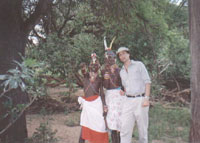
Costas tracking elephants with Samburu warriors.
But my visit today is not about reliving the past. Rather, I have come back to Samburu to learn about one of Africa’s newest ecotourism ventures, Elephant Watch Safaris. This is the brain-child of Kenya-born Oria Douglas-Hamilton, who together with her husband Iain, is one of the world’s leading experts on African elephant behavior and ecology.
Shocked at the dramatic drop in elephant populations across Africa due to massive ivory poaching in the 1980s, Oria and Iain supported a worldwide conservation crusade to ban the ivory trade and put an end to poaching. In 1993, Iain set up Save The Elephants, a nonprofit organization dedicated to elephant research and conservation. He established his research camp in Samburu Game Reserve beside a rocky hill along the Uaso Nyiro River, the only permanent water source in the area and the lifeline of the Samburu ecosystem — the very spot where I lived in a tent while studying monkeys 24 years ago.
While Iain prepared to monitor the movements of elephants using radio collars, Oria hatched another plan. “The idea came to me as I was sitting on the roof of my Land Rover, watching elephants,” she explains. “A young female walked towards me and lifted her trunk. I held out my hand to the tip of her nose and murmured a low rumble call while her warm breath flowed over my fingers. For a while, she remained by the car, flapping her ears, ripping grass, and twirling her trunk.” Her idea was to set up an ecotourism experience that would allow visitors to track and observe wild elephants with trained guides.
Monitoring elephant movements within Samburu Game Reserve using radio technology.
Employing only local Samburu people as guides, Oria established a small camp in the reserve and hired Renee Kuriyan, a bright, young American woman who had been working with Iain, to be her assistant. The goal of the project is to generate income and conservation awareness among local communities while also providing visitors with an in-depth, first-hand education in elephant behavior and ecology.
I arrive in time to join Renee for lunch in the Elephant Watch Safaris camp. The table is under the canopy of a large Acacia Elatior tree beside the river. Elephants appear at the edge of the camp, colorful birds are everywhere, and baboons play nearby. Renee explains to me that she is working closely with two local villages, Kiltamany and Lpus Lilowe, that have been involved with the ecotourism venture from the outset. At the request of the locals, a percentage of the income from the project will go towards establishing a training fund, rather than going directly into villagers’ pockets. The fund will support educational opportunities — a priority for the community — as well as other community needs.
Although much of the community work is just starting and Elephant Watch Safaris is new, the project has already supported four full educational scholarships for village children and has helped to establish a women’s handicraft collective. As we talk during lunch, I am impressed with Renee’s grasp of the complexities of making ecotourism work and of her commitment to doing so.
I spent the afternoon tracking elephants with guide Sammy Lemantampsh and a young Samburu warrior named Sumoro Lecharkole. Sumoro has been mobilizing his community to keep cattle out of the park and to monitor the movements of any elephants spotted outside of the protected area. When we visit his village, several members come to him to report seeing an elephant with an injured foot. From the description, Sumoro and Sammy recognize the elephant as Mandela, one of the bulls they are monitoring. Sammy notes the information down for the Save The Elephants team. Later, Sammy, Sumoro, Renee, and I come upon an unusually large herd of bulls and Sammy writes down its exact location and the number of animals in ther herd.
With African elephants being wiped out by poaching in many parts of the continent, every effort to save them is needed. Elephant Watch Safaris is one way that ecotourism can contribute to that effort.
Friday, 22 Mar 2002
NAIROBI, Kenya
Some two hundred people are gathered in a conference room in downtown Nairobi to talk ecotourism. Nearly all are from rural communities in Kenya, but others from Tanzania, Uganda, Ethiopia, Botswana, Ghana, and Zanzibar. There are delegations of Maasai and Samburu elders as well as warriors and women. There are representatives from the Gudigwa Khwe Bushman people in southern Africa, the Mjikenda coastal communities of East Africa, and the Ashanti of West Africa.
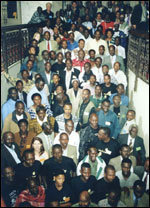
Participants at the African regional ecotourism meeting.
I am attending the Africa regional preparatory meeting of the International Year of Ecotourism, one in a series of six meetings to be held around the world, leading up to the U.N. World Ecotourism Summit taking place in Quebec, Canada in May. Conservation International (the organization I work for) has partnered with UNEP, the International Ecotourism Society, Rainforest Alliance, and a host of local and national community groups, tourism associations, and environmental organizations, in supporting these regional meetings. The goal is to review ecotourism, learn from positive and negative examples, and set a regional agenda to be carried by local delegates to the World Ecotourism Summit.
The task of a achieving a global ecotourism dialogue is both daunting and urgent. Tourism, even after Sept. 11, remains one of the biggest industries worldwide. The World Tourism Organization reports that tourism related activities accounted for the primary source of international trade receipts in 2000. Add to that statistics showing that nature and adventure tourism are the fastest growing sectors of the industry, and it is enough to make one pause for thought.
At Conservation International, we have identified 25 global biodiversity “hotspots” — places that contain the Earth’s greatest number of species under the greatest threat of extinction. These hotspots represent less than 1.4 percent of the Earth’s land surface, yet contain more than 60 percent of the world’s terrestrial species. In almost every hotspot, tourism is growing. These same areas also have some of the poorest populations on Earth — people who struggle to meet basic needs for survival. So, in the world’s greatest biodiversity areas, we find the last frontier for many animals and plants under threat of extinction, a make-or-break world of survival for millions of humans, and the growth of tourism.
The result is that we are at a crossroads. Left to it’s own devices, without standards or principles to guide it, mass tourism can have devastating consequences. Science magazine has reported that Woolong Nature Reserve in China, set aside as a safe haven for Giant Pandas 30 years ago, has less intact panda habitat today inside park borders than outside, the result of uncontrolled tourism growth. In Kenya’s Amboseli National Park, researchers directly linked uncontrolled mass tourism in the 1980s and 1990s to a decline in cheetah reproductive rates. On Monday, I described the impact mass tourism had on Samburu Game Reserve in the late 1970s. And Cancun’s development in Mexico’s Yucatan peninsula has resulted in a huge loss of biodiversity in the area, in addition to dislocating and marginalizing indigenous peoples.
These are the issues that gave rise to ecotourism. Within tourism’s monolithic and scary growth there is an opportunity to be seized. An opportunity that calls for tourism to be guided by ethical principles of sustainability and cultural sensitivity, that demands tourism respect the Earth and its inhabitants, and calls upon tourism to “protect nature and sustain the well being of local peoples.” It is the basis upon which ecotourism stands as a set of principles to be applied to the widest segment of the world tourism industry as possible.
Will ecotourism save the world? Not in my view. Will it deliver all that it promises? Not necessarily. But one thing is certain: There has been enough initial successes with ecotourism in all corners of the globe during the last decade to make it a means to conserve nature and alleviate poverty. A number of these successes are found right here in Kenya, and the Kenyan people are determined to build on them.
Around the room, Africans are debating ecotourism’s practicality in different settings, sharing success stories, analyzing problems, and setting the agenda for future ecotourism development. In the process, they are helping to bring ecotourism to the next level — to a place where the principles of ecotourism can influence a wide spectrum of the tourism industry to play a more direct and meaningful role in nature conservation, environmental sustainability, and community development. There is no time to waste.


